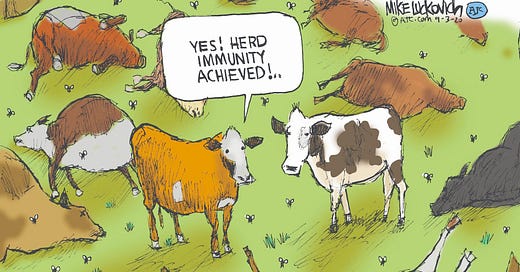"Let it rip" for chickens? Don't put your eggs in that basket.
The Great Birdington Declaration
Speaking about highly pathogenic avian influenza (HPAI, or Bird Flu), a certain US Health and Human Services Secretary recently suggested on national television that we:
“should consider maybe the possibility of letting it run through the flock so that we can identify the birds, and preserve the birds, that are immune to it.”
I’m all for some out-of-the-box thinking on how to save the chickens from mass death and bring down egg prices…but some ideas should stay in the box for very good reasons.
Unfortunately, “letting it rip” won’t bring back cheap eggs and could be a recipe for disaster for several reasons:
· The virus is highly contagious- if a single bird is infected it usually spreads to the entire flock.
· The virus is highly lethal, killing close to 90-100% of infected poultry- it’s called “highly pathogenic” for a reason. (And no, vitamin A and apple cider vinegar won’t help here).
Image credit: Mike Lukovich cartoons
· Death from H5N1 is horrible for the animal. Common symptoms include swollen heads, twisted necks, and breathing difficulties.
· Letting the virus spread at an infected farm makes it much more likely the virus will spread to other flocks or human workers. This is the really important point for containing the virus from further spread: dead chickens can’t transmit.
· More infections=more chances to mutate into a virus with human pandemic potential. A “let it rip” strategy would lead to millions more infections, gifting the virus millions more “lottery tickets” or chances to gain mutations that could transmit better in humans. (While the Health Secretary has suggested bird flu vaccines might lead to such mutations, vaccines work in the opposite direction by reducing infections and transmission and thus providing fewer opportunities for mutation.)
So overall, a strategy of “letting it run through the flock” would:
1) NOT save birds in infected flocks, but inflict extreme suffering before death.
2) Lead to more overall transmission within and between flocks -meaning fewer eggs and more chances for the virus to mutate into a version that can transmit among humans.
Because of these harsh realities of Mother Nature, “culling” or mass killing of all birds has become the main way to control the virus and minimize the risk of it jumping to humans. Globally around 500 million birds have been killed in the past 3 years, including 166 millionin the US, and 3 million in the UK.
There is no doubt that culling is a tragic outcome for farmers and chickens alike. While governments partially compensate farmers for their flocks, such a loss is still devastating on many levels, and we should be working hard on other ways to limit spread to minimize this last line of defense.
While there are avian flu vaccines available, the cost/benefits of vaccination are not straightforward for several reasons including the logistics of administration and a lack 100% protection from infection. Nonetheless, some countries including China, Vietnam, Egypt, and France have moved from culling to vaccination in recent years and had success dramatically reducing their outbreaks.
Sadly, there are no easy solutions to the H5N1 challenge facing the globe. But it is encouraging that the US Department of Agriculture has recently released a 5-pronged plan to combat Avian flu (and reduce the price of eggs!). The plan includes investments in biosecurity to help farms better safeguard against infection from wild birds and transmission in their facilities, as well as money for vaccines and therapeutics.
As with many highly pathogenic human infections (such as cholera, polio, tuberculosis), “herd immunity” to reduce mortality doesn’t work. These devastating illnesses were finally brought under control not by mass infection but through public health measures to control transmission as well as vaccines. This is the playbook that can also work for bird flu, even if the details and specific tradeoffs are still being worked out.
Image credit: xkcd comics
So hang in there. Just remember that we need fewer rather than more infections to bring back the eggs!
Jenn
Links:
Which came first, the chicken slaughter or the egg shortage? Wall Street Journal
Bird Flu Update, March 2025, Those Nerdy Girls
Here’s what RFK, JR got wrong about H5N1 Bird Flu, MedPage Today
Kennedy’s Alarming Prescription for Bird Flu on Poultry Farms, New York Times
All creatures great and culled: inside the global bird flu poultry slaughter, The Telegraph






Sensible advice, delivered with data and humour! As usual, the comics speak volumes.
Subscribed! Looking forward to this, thanks for sharing your great work.